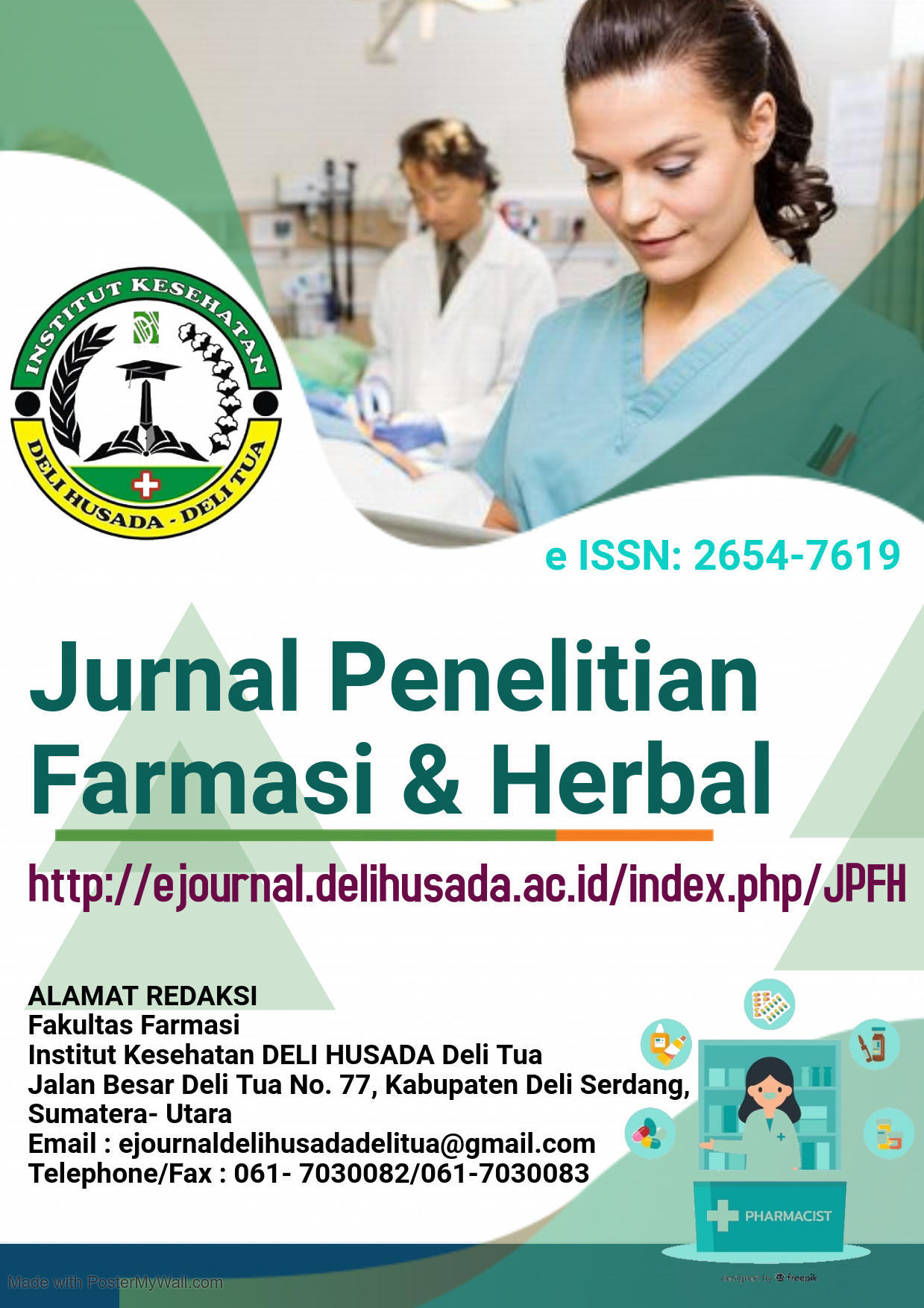AKTIVITAS ANTIOKSIDAN DAN KEMAMPUAN ANTIBAKTERI EKSTRAK KULIT BUAH KENITU (Chrysophyllum cainito L) TERHADAP Staphylococcus aureus
Abstract
Kenitu (Chrysophyllum cainito L) has strong antioxidant properties both in vitro and in vivo. The presence of this high antioxidant can be used as a natural agent to prevent and treat diseases associated with an imbalance of antioxidant levels in the body, such as diabetes. Some research results state that kenitu can be used as an antidiabetic. One type of complication in people with diabetes mellitus is the occurrence of bacterial infections of the skin. One type of bacteria that infects the most is Staphylococcus aureus. So far, the skin of the kenitu fruit has only been thrown away and has not been used. The purpose of this study was to determine the antioxidant activity of kenitu peel extract and to determine the ability of kenitu peel extract as an antibacterial against Staphylococcus aureus. Research methods included extracting kenitu peel by maceration using 70% ethanol, testing antioxidant activity using the DPPH method, and testing the antibacterial activity of kenitu peel extract against Staphylococcus aureus. The results of the antioxidant activity test showed an IC50 value of 126.96 ppm. Antibacterial activity testing showed a MIC value of 250 ppm and a MBC value of 500 ppm. The conclusion of this study is that kenitu peel extract has moderate antioxidant activity and kenitu peel extract is able to inhibit the growth and kill Staphylococcus aureus bacteria.
Downloads
References
Arrijal, I. M. H., Ma’arif, B., & Suryadinata, A. (2018). ACTIVITY OF ETHYL ACETATE EXTRACT FROM Chrysophyllum cainito L. LEAVES IN DECREASING BLOOD SUGAR LEVEL IN MALE WISTAR RATS. Journal of Islamic Pharmacy, 3(1), 31. https://doi.org/10.18860/jip.v3i1.4996
Doan, H. V., & Le, T. P. (2020). Chrysophyllum cainito: A Tropical Fruit with Multiple Health Benefits. Evidence-Based Complementary and Alternative Medicine, 2020, 1–9. https://doi.org/10.1155/2020/7259267
Fitriana, Y. A. N., Fatimah, V. A. N., & Shabrina, A. (2019). Aktivitas Anti Bakteri Daun Sirih: Uji Ekstrak KHM (Kadar Hambat Minimum) dan KBM (Kadar Bakterisidal Minimum). 16(2).
Herawati, N. (2012). Pengujian Antiradikal Bebas Difenilpikril Hidrazil (DPPH) Kulit Batang Sonneratia alba.
James, CS. (n.d.). Analytical chemistry of Foods.
Khairunnisa, Soleha, Ramadhian. (2020). Identifikasi dan Uji Resistensi Staphylococcus aureus Pada Ulkus Diabetik di Instalasi Penyakit Dalam RSUD Dr. H. Abdul Moeloek. J. Agromedicine Unila. 7 (1)
Koffi, N., Ernest, A. K., Marie-Solange, T., Beugré, K., & Noël, Z. G. (2009). Effect of aqueous extract of Chrysophyllum cainito leaves on the glycaemia of diabetic rabbits. 6.
Mustofa. (2018). Aktivitas Ekstrak Etil Asetat Daun Kenitu (Chrysophyllum cainito) Terhadap Peningkatan Kepadatan Tulang Traberkular Vertebra Mencit Betina yang Diinduksi Deksametason. Skripsi
Ningsih, I. Y., Zulaikhah, S., Hidayat, Moch. A., & Kuswandi, B. (2016). Antioxidant Activity of Various Kenitu (Chrysophyllum Cainito L.) Leaves Extracts from Jember, Indonesia. Agriculture and Agricultural Science Procedia, 9, 378–385. https://doi.org/10.1016/j.aaspro.2016.02.153
Oranusi, S. U., Braide, W., & Umeze, R. U. (2015). Antimicrobial Activities and Chemical Compositions Of Chrysophyllum Cainito (Star Apple) Fruit. 17.
Purwanto, D., Bahri, S., & Ridhay, A. (2017). UJI AKTIVITAS ANTIOKSIDAN EKSTRAK BUAH PURNAJIWA (Kopsia arborea Blume.) DENGAN BERBAGAI PELARUT. KOVALEN, 3(1), 24. https://doi.org/10.22487/j24775398.2017.v3.i1.8230
Rahayu, Kawuri, Suriani. (2014). Uji Keberadaan Staphylococcus aureus Pada Sosis Tradisional (Urutan) yang Beredar di Pasar Tradisional di Denpasar, Bali. Jurnal Simbiosis. II(1).
Risnawati, Yusuf, Syam. (2018). Identifikasi Jenis Bakteri Pada Luka Kaki Diabetik Berdasarkan Lama Menderita Luka. Jurnal Kesehatan Manarang. 4(2)
Rizqiyah, Soleha, Hanriko, Apriliana. (2020). Pola Bakteri Ulkus Diabetikum Pada Penderita Diabetes Mellitus di RSUD Dr. H. Abdul Moeloek. J. Majority. 9(2).
Roni, A., Fitriani, L., & Marliani, L. (2019). Penetapan Kadar Total Flavonoid, Fenolat, dan Karotenoid, serta Uji Aktivitas Antioksidan dari Daun dan Kulit Batang Tanaman Kenitu (Chrysophyllum cainito L.). Jurnal Sains dan Kesehatan, 2(2), 83–88. https://doi.org/10.25026/jsk.v2i2.114
Saefudin, Marusin, Chairul. (2013). Aktivitas Antioksidan Pada Enam Jenis Tumbuhan Sterculiaceae. Jurnal Penelitian Hasil Hutan. 31(2)
Sugireng, Rosdarni. (2020). Deteksi MRSA (Methicilin Resistant Staphylococcus aureus) dengan Metode PCR Pada Pasien Ulkus Diabetikum. Prosiding Seminar Nasional Biologi
Sultana, R., Rai, D., Vasanth, S., & Ahmed, G. (2021). A Pharmacognostic and Pharmacological Review on Chrysophyllum cainito L. 5.
Suparwati, Sukarni, Fradianto. (2022). Identifikasi Bakteri Pada Luka Kaki Diabetes yang Mengalami Infeksi : Kajian Literatur. Berkala Ilimah Mahasiswa Ilmu Keperawatan Indonesia. 10(1). https://doi.org/10.53345/bimiki.v10i1.235
Utaminingtyas. 2017. Uji Aktivitas Ekstrak Etanol 70% Daun Kenitu (Chrysophyllum cainito) Terhadap Peningkatan Kepadatan Tulang Traberkular Vertebra Mencit Betina yang Diinduksi Deksametason. Skripsi
Yuli Widiastuti. (2020). Pengembangan Standar Simplisia Untuk Menjamin Mutu dan Keamanan Obat Tradisional







